Distribution Characteristics and Hydrocarbon Significance of Deep-Water Fine-Grained Sedimentary Rocks in the Steep-Slope Zone of a Graben Lake Basin: A Case Study of Es3l sub-Member in the Jiyang Depression, Bohai Bay Basin, China
Abstract
1. Introduction
2. Geological Settings
3. Materials and Methods
4. Petrological Characteristics and Analysis of Lithofacies Genesis
4.1. Petrological Characteristics
4.1.1. Mineralogical Characteristics
4.1.2. Sedimentary Structural Characteristics
4.2. Lithofacies Classification and Genesis Analysis
4.2.1. Classification of Lithofacies Types
4.2.2. Main Lithofacies Characteristics and Genesis Mechanism
- Terrigenous low-organic rich massive siltstone (LF1)
- 2.
- Terrigenous low-organic-matter massive mudstone (LF2)
- 3.
- Mixed-source medium-organic-matter massive mudstone (LF3)
- 4.
- Mixed-source medium-to-high-organic-matter layer-massive mudstone (LF4)
- 5.
- Mixed-source medium-to-high-organic-matter laminated mudstone (LF5)
- 6.
- Endogenic medium-to-high-organic-matter laminated marl (LF6)
5. Spatiotemporal Distribution Patterns and Depositional Models
5.1. Distribution Characteristics of Profile Lithofacies
5.2. Distribution Characteristics of Planar Lithofacies
5.3. Depositional Model
5.4. “Sweet Spot” Lithofacies Quality Evaluation and Prediction
5.4.1. “Sweet Spot” Lithofacies Quality Evaluation
5.4.2. Prediction of Favorable Lithofacies
6. Conclusions
Author Contributions
Funding
Data Availability Statement
Conflicts of Interest
References
- Zou, C.N.; Pan, S.Y.; Jing, Z.H.; Gao, J.L. Shale oil and gas revolution and its impact. Acta Pet. Sin. 2020, 41, 1–12, (In Chinese with English abstract). [Google Scholar]
- Atchley, S.C.; Crass, B.T.; Prince, K.C. The prediction of organic-rich reservoir facies within the Late Pennsylvanian Cline shale (also known as Wolfcamp D), Midland Basin, Texas. AAPG Bull. 2021, 105, 29–52. [Google Scholar] [CrossRef]
- Xin, B.; Hao, F.; Han, W.; Xu, Q.; Guo, P.; Tian, J. Shale oil enrichment models under different thermal maturity levels in the Paleogene lacustrine shales: Implications for shale oil exploration. J. Asian Earth Sci. 2023, 256, 105808. [Google Scholar] [CrossRef]
- Chen, Y.E.; Li, L.; Zhang, Z.; Greenwood, P.F.; Liu, Y. Biodegradation of occluded hydrocarbons and kerogen macromolecules of the Permian Lucaogou shales, Junggar Basin, NW China. Energy Geosci. 2023, 4, 179–184. [Google Scholar] [CrossRef]
- Balogun, O.B.; Akintokewa, O.C. Pre-rig mobilization hazard evaluation in offshore oil and gas prospect drilling: A case study of TM field, offshore Niger Delta. Energy Geosci. 2023, 4, 158–178. [Google Scholar] [CrossRef]
- Liu, H.M.; Li, J.L.; Li, P.; Wang, X.; Wang, Y.; Qiu, Y.B.; Li, Z.; Wang, W.Q. Enrichment conditions and strategic exploration direction ofPaleogene shale oil in Jiyang depression. Acta Pet. Sin. 2022, 43, 1717–1729, (In Chinese with English abstract). [Google Scholar]
- Liu, H.M.; Li, Z.; Bao, S.Y.; Zhang, S.C.; Wang, W.Q.; Wu, L.B.; Wang, Y.; Zhu, R.F.; Fang, Z.W.; Zhang, S.; et al. Geology of shales in prolific shale-oil well BYP5 in the Jiyang Depression.Bohai Bay Basin. Oil Gas Geol. 2023, 44, 1405–1417, (In Chinese with English abstract). [Google Scholar]
- Liu, T.; Jiang, Z.; Jia, H.; Wu, X.; Yu, J.; Zhao, B.; Wei, S. Controlling factors of the gypsum-salt strata differences within two adjacent Eocene sags in the eastern Jiyang Depression, NE China and its hydrocarbon significance. Geoenergy Sci. Eng. 2023, 231, 212352. [Google Scholar] [CrossRef]
- Yang, T.; Cao, Y.C.; Wang, Y.Z.; Cai, L.X.; Liu, H.N.; Jin, J.H. Sedimentary characteristics and depositional model of hyperpycnites in the gentle slope of a lacustrine rift basin: A case study from the third member of the Eocene Shahejie Formation, Bonan Sag, Bohai Bay Basin, Eastern China. Basin Res. 2023, 35, 1590–1618. [Google Scholar] [CrossRef]
- Fawad, N.; Liu, T.; Fan, D.; Ahmed, Q.A.; Kamran, M.; Ayub, G. Sequence stratigraphic divisions and correlation of the middle sub-member of Eocene Shahejie Formation in the Bonan Sag of Bohai Bay Basin (China): Implication for facies and reservoir heterogeneities. Geoenergy Sci. Eng. 2023, 225, 211622. [Google Scholar] [CrossRef]
- Cao, Y.C.; Jin, J.H.; Liu, H.N.; Yang, T.; Liu, K.Y.; Wang, Y.Z.; Wang, J.; Liang, C. Deep-water gravity flow deposits in a lacustrine rift basin and theiroil and gas geological significance in eastern China. Pet. Explor. Dev. 2021, 48, 247–257. [Google Scholar] [CrossRef]
- Ma, X.H.; Wang, H.Y.; Zhao, Q.; Liu, Y.; Zhou, S.W.; Hu, Z.M.; Xiao, Y.F. “Extreme utilization” development of deep shale gas in southern Sichuan Basin, SW China. Pet. Explor. Dev. 2022, 49, 1190–1197. [Google Scholar] [CrossRef]
- Wang, Y.H.; Ding, W.M.; Liu, X.; Wei, R.; Dong, L. Lithofacies and causal mechanism of organic matter enrichment inthe lower submember of the 3rd member of Shahejie Formation, Bonan Sag, Bohai Bay Basin. Oil Gas Geol. 2019, 40, 1106–1114, (In Chinese with English abstract). [Google Scholar]
- Liu, P. Diagenetie evolution difference of clastic reservoirs in differentsystem tract: A case study of 3rd member of ShahejieFormation in Bonan Sag, Jiyang Depression. Pet. Geol. Recovery Effic. 2019, 26, 60–67, (In Chinese with English abstract). [Google Scholar] [CrossRef]
- Ma, L.; Song, M.; Wang, Y.; Wang, Y.; Liu, H. Exploration progress of the Paleogene in Jiyang Depression, Bohai Bay Basin. Energy Geosci. 2023, 4, 42–50. [Google Scholar] [CrossRef]
- Zhang, J.G.; Jiang, Z.X.; Liu, L.A.; Yuan, F.; Feng, L.Y.; Li, C.S. Lithofacies and depositional evolution of fine grained sedimentary rocks in the lower submember of the Member 3 of Shahejie Formation in Zhanhua sag, Bohai Bay Basin. Acta Pet. Sin. 2021, 42, 293–306, (In Chinese with English abstract). [Google Scholar]
- Wang, Y.; Liu, H.M.; Song, G.Q.; Xiong, W.; Zhu, D.S.; Zhu, D.Y.; Yin, Y.; Ding, J.H.; Yang, W.Q.; Zhang, L.; et al. Lacustrine shale fine grained sedimentary system in Jiyang depression. Acta Pet. Sin. 2019, 40, 395–410, (In Chinese with English abstract). [Google Scholar]
- Bai, C.; Yu, B.; Han, S.; Shen, Z. Characterization of lithofacies in shale oil reservoirs of a lacustrine basin in eastern China: Implications for oil accumulation. J. Pet. Sci. Eng. 2020, 195, 107907. [Google Scholar] [CrossRef]
- Liu, H.M.; Yu, B.S.; Xie, Z.H.; Han, Z.Y.; Shen, Z.H.; Bai, C.Y. Charaeteristics and implications of micro-lithofacies in lacustrine basin organic rich shale: A case study of Jiyang depression, Bohai Bay Basin. Acta Pet. Sin. 2018, 39, 1328–1343, (In Chinese with English abstract). [Google Scholar]
- Liu, Y.L.; Liu, P. Interlayer characteristics and their effect on continental facies organic-rich shale: A case study of Jiyang Depression. Pet. Geol. Recovery Effic. 2019, 26, 1–9, (In Chinese with English abstract). [Google Scholar] [CrossRef]
- Yang, K.; Zhu, X.M.; Yang, H.Y.; Zhu, S.F.; Dong, Y.L.; Jin, L.; Shen, T.T.; Ye, L. Multi Method Characterization of a Paleo-provenance System: A case study from the lower 4th member of the Shahejie Formation from the Bonan Sag in Zhanhua Depression, Bohai Bay Basin. Acta Sedimentol. Sin. 2022, 40, 1542–1560, (In Chinese with English abstract). [Google Scholar] [CrossRef]
- Hua, Y.; Guo, X.; Tao, Z.; He, S.; Dong, T.; Han, Y.; Yang, R. Mechanisms for overpressure generation in the bonan sag of Zhanhua depression, Bohai Bay Basin, China. Mar. Pet. Geol. 2021, 128, 105032. [Google Scholar] [CrossRef]
- Wang, Y.S.; Zhang, S. Formation mechanism of high-quality reservoirs in deep strata of Paleogene, Bonan Subsag, Zhanhua Sag, Bohai Bay Basin. Pet. Geol. Exp. 2023, 45, 11–19. [Google Scholar]
- Liu, H.; Jiang, Y.; Song, G.; Gu, G.; Hao, L.; Feng, Y. Overpressure characteristics and effects on hydrocarbon distribution in the Bonan Sag, Bohai Bay Basin, China. J. Pet. Sci. Eng. 2017, 149, 811–821. [Google Scholar] [CrossRef]
- Feng, Y.; Liu, H.; Song, G.; Yuan, F.; Li, J.; Jiang, Z. Relationship between decreased pressure gradient and reservoir filling degree of paleogene in Bonan Sag. J. Pet. Sci. Eng. 2019, 180, 615–630. [Google Scholar] [CrossRef]
- Yang, H.-F.; Qian, G.; Zhao, M.; Gao, Y.-F.; Su, W.; Xu, Y.-H. Sediment supply mechanism and its influence on hydrocarbon accumulation in the Paleogene of the northern Huanghekou Sag, Bohai Bay Basin, China. J. Palaeogeogr. 2023, 12, 229–245. [Google Scholar] [CrossRef]
- Xia, R.; Zhang, J.; Zhong, Q. Study on the Differential Distribution Patterns of Fine-Grained Sedimentary Rocks in the Lower Third Member of the Shahejie Formation in Zhanhua Sag, Bohai Bay Basin. Minerals 2024, 14, 70. [Google Scholar] [CrossRef]
- Zhang, J.G.; Jiang, Z.X.; Liu, P.; Kong, X.X.; Ge, Y.J. Deposition mechanism and geological assessment of continentaultrafine grained shale oil reservoirs. Acta Pet. Sin. 2022, 43, 234–249, (In Chinese with English abstract). [Google Scholar]
- Liu, H.; Li, J.; Feng, Y.L.; Hao, X.F.; Lin, H.M.; Yuan, F.F. Relationship between excess pressure gradient and hydrocarbon distribution in the 3rd member of Shahejie Formation in Bonan Sag, Bohai Bay Basin. Oil Gas Geol. 2020, 41, 1083–1091, (In Chinese with English abstract). [Google Scholar]
- Jiang, Z.X.; Zhang, J.G.; Kong, X.X.; Xie, H.Y.; Cheng, H.; Wang, L. Research progress and development direction of continental shale oil and gasdeposition and reservoirs in China. Acta Pet. Sin. 2023, 44, 45–71, (In Chinese with English abstract). [Google Scholar]
- Cao, Y.C.; Liang, C.; Han, Y.; Xi, K.L.; Wang, J.R.; Ji, S.C.; Mei, J.F. Discussions on classification scheme for fine-grained sedimentary rocks based on sediments sources and genesis. J. Palaeogeogr. Chin. Ed. 2023, 25, 729–741, (In Chinese with English abstract). [Google Scholar]
- He, J.H.; Ding, W.L.; Jiang, Z.X.; Jiu, K.; Li, A.; Sun, Y.X. Mineralogical and chemical distribution of the Es3l oil shale in the Jiyang Depression, Bohai Bay Basin (E China): Implications for paleoenvironmental reconstruction and organic matter accumulation. Mar. Pet. Geol. 2017, 81, 196–219. [Google Scholar] [CrossRef]
- Holditch, S.A. Unconventional oil and gas resource development—Let’s do it right. J. Unconv. Oil Gas Resour. 2013, 1–2, 2–8. [Google Scholar] [CrossRef]
- Davies, R.J.; Almond, S.; Ward, R.S.; Jackson, R.B.; Adams, C.; Worrall, F.; Herringshaw, L.G.; Gluyas, J.G.; Whitehead, M.A. Oil and gas wells and their integrity: Implications for shale and unconventional resource exploitation. Mar. Pet. Geol. 2014, 56, 239–254. [Google Scholar] [CrossRef]
- Zhu, D.S. Influencing factor analysis and comprehensive evaluation method of lacustrine shale oil: Cases from dongying and zhanhua sags. Xinjiang Pet. Geol. 2019, 40, 269–275, (In Chinese with English abstract). [Google Scholar]
- Liang, C.; Wu, J.; Jiang, Z.X.; Cao, Y.C.; Liu, S.J.; Pang, S.Y. Significances of organic matters on shale deposition, diagenesis process and reservoir formation. J. China Univ. Pet. 2017, 41, 1–8, (In Chinese with English abstract). [Google Scholar]
- Schieber, J.; Southard, J.B.; Kissling, P.; Rossman, B.; Ginsburg, R. Experimental Deposition of Carbonate Mud From Moving Suspensions: Importance of Flocculation and Implications For Modern and Ancient Carbonate Mud Deposition. J. Sediment. Res. 2013, 83, 1025–1031. [Google Scholar] [CrossRef]
- Tyson, R.V. Sedimentation rate, dilution, preservation and total organic carbon: Some results of a modelling study. Org. Geochem. 2001, 32, 333–339. [Google Scholar] [CrossRef]
- Chen, G.; Gang, W.; Liu, Y.; Wang, N.; Jiang, C.; Sun, J. Organic matter enrichment of the Late Triassic Yanchang Formation (Ordos Basin, China) under dysoxic to oxic conditions: Insights from pyrite framboid size distributions. J. Asian Earth Sci. 2019, 170, 106–117. [Google Scholar] [CrossRef]
- Tripsanas, E.K.; Piper, D.J.W.; Jenner, K.A.; Bryant, W.R. Submarine mass-transport facies: New perspectives on flow processes from cores on the eastern North American margin. Sedimentology 2007, 55, 97–136. [Google Scholar] [CrossRef]
- Hakro, A.A.A.D.; Ali, S.; Mastoi, A.S.; Rajper, R.H.; Awan, R.S.; Samtio, M.S.; Xiao, H.; Lu, X. Mineralogy and element geochemistry of the Sohnari rocks of Early Eocene Laki Formation in the Southern Indus Basin, Pakistan: Implications for paleoclimate, paleoweathering and paleoredox conditions. Energy Geosci. 2023, 4, 143–157. [Google Scholar] [CrossRef]
- Ma, Y.; Fan, M.; Lu, Y.; Guo, X.; Hu, H.; Chen, L.; Wang, C.; Liu, X. Geochemistry and sedimentology of the Lower Silurian Longmaxi mudstone in southwestern China: Implications for depositional controls on organic matter accumulation. Mar. Pet. Geol. 2016, 75, 291–309. [Google Scholar] [CrossRef]
- Ma, Y.C. Lacustrine Shale Stratigraphy and Eocene Climate Recorded in the Jiyang Depression in East China; China University of Geosciences: Wuhan, China, 2018; (In Chinese with English abstract). [Google Scholar]
- Xie, Z.K. Research on the Quaternary fine-fraction lithofacies and sedimentation model in Tainan area, Qaidam Basin. Geosci. Front. 2009, 16, 245–250. [Google Scholar] [CrossRef]
- Arthur, M.A.; Sageman, B.B. MARINE BLACK SHALES: Depositional Mechanisms and Environments of Ancient Deposits. Annu. Rev. Earth Planet. Sci. 1994, 22, 499–551. [Google Scholar] [CrossRef]
- Heiskanen, A.S. Contamination of sediment trap fluxes by vertically migrating phototrophic micro-organisms in the coastal Baltic Sea. Mar. Ecol. Prog. Ser. 1995, 122, 45–58. [Google Scholar] [CrossRef]
- Talling, P.J.; Masson, D.G.; Sumner, E.J.; Malgesini, G. Subaqueous sediment density flows: Depositional processes and deposit types. Sedimentology 2012, 59, 1937–2003. [Google Scholar] [CrossRef]
- Jin, C.Z.; Dong, B.W.; Bai, Y.F.; Lv, J.C.; Fu, X.L.; Li, J.; Ma, S.M. Lithofacies characteristics and genesis analysis of Gulong shale in Songliao Basin. Pet. Geol. Oilfield Dev. Daqing 2020, 39, 35–44, (In Chinese with English abstract). [Google Scholar] [CrossRef]
- Wang, X.R.; Sun, Y.; Liu, R.H.; Li, Z. Research progress into fine-grained sedimentary rock characteristics and formation in a continental lake basin. Acta Sedimentol. Sin. 2023, 41, 349–377, (In Chinese with English abstract). [Google Scholar] [CrossRef]
- Zou, C.; Qiu, Z.; Wei, H.; Dong, D.; Lu, B. Euxinia caused the Late Ordovician extinction: Evidence from pyrite morphology and pyritic sulfur isotopic composition in the Yangtze area, South China. Palaeogeogr. Palaeoclimmatol. Palaeoecol. 2018, 511, 1–11. [Google Scholar] [CrossRef]
- Zolitschka, B.; Francus, P.; Ojala, A.E.K.; Schimmelmann, A. Varves in lake sediments—A review. Quat. Sci. Rev. 2015, 117, 1–41. [Google Scholar] [CrossRef]
- Austin, J. Observations of near-inertial energy in Lake Superior. Limnol. Oceanogr. 2013, 58, 715–728. [Google Scholar] [CrossRef]
- Riding, R. Microbial carbonates: The geological record of calcified bacterial–algal mats and biofilms. Sedimentology 2002, 47, 179–214. [Google Scholar] [CrossRef]
- Pandey, V.; Chotaliya, B.; Bist, N.; Yadav, K.; Sircar, A. Geochemical analysis and quality assessment of geothermal water in Gujarat, India. Energy Geosci. 2023, 4, 59–73. [Google Scholar] [CrossRef]
- Kelts, K.; Talbot, M. Lacustrine carbonates as geochemical archives of environmental change and biotic/abiotic interactions. In Large Lakes; Ecological Structure and Function; Springer: Berlin/Heidelberg, Germany, 1990; pp. 288–315. [Google Scholar]
- Kong, X.; Jiang, Z.; Han, C.; Zheng, L.; Zhang, Y.; Zhang, R.; Tian, J. Genesis and implications of the composition and sedimentary structure of fine-grained carbonate rocks in the Shulu sag. J. Earth Sci. 2017, 28, 1047–1063. [Google Scholar] [CrossRef]
- Yang, W.Q. Shale Lithofacies Characteristics and Development Rule of the Lower Es3 and Upper Es4, Dongying Sag; China University of Petroleum (East China): Qingdao, China, 2020; (In Chinese with English abstract). [Google Scholar]
- Wang, M.; Wilkins, R.W.T.; Song, G.; Zhang, L.; Xu, X.; Li, Z.; Chen, G. Geochemical and geological characteristics of the Es3L lacustrine shale in the Bonan sag, Bohai Bay Basin, China. Int. J. Coal Geol. 2015, 138, 16–29. [Google Scholar] [CrossRef]
- Lu, S.; Liu, W.; Wang, M.; Zhang, L.; Wang, Z.; Chen, G.; Xiao, D.; Li, Z.; Hu, H. Lacustrine shale oil resource potential of Es3l Sub-Member of Bonan Sag, Bohai Bay Basin, Eastern China. J. Earth Sci. 2017, 28, 996–1005. [Google Scholar] [CrossRef]
- Mulder, T.; Syvitski, J.P.M. Turbidity Currents Generated at River Mouths during Exceptional Discharges to the World Oceans. J. Geol. 1995, 103, 285–299. [Google Scholar] [CrossRef]
- Lowe, D.R. Sediment gravity flows: II. Depositional models with special reference to the deposits of high-density turbidity currents. J. Sediment. Res. 1982, 52, 279–297. [Google Scholar]
- Shi, Z.S.; Wang, H.Y.; Zhao, S.X.; Zhou, T.Q.; Zhao, Q.; Qi, L. Rapid transgressive shale characteristics and organic matter distribution of the Upper Ordovician—Lower Silurian Wufeng—Longmaxi Formations in southern Sichuan Basin, China. J. Palaeogeogr. Chin. Ed. 2023, 25, 788–805, (In Chinese with English abstract). [Google Scholar]
- Ge, Z.Y.; Xu, H.X. Hydraulic and sedimentary responses of turbidity current to structurally-controlled topography. J. Palaeogeogr. Chin. Ed. 2023, 25, 1090–1117, (In Chinese with English abstract). [Google Scholar]
- Jiang, Z.X.; Wang, J.H.; Zhang, Y.F.; Zhang, J.G.; Song, M.S.; Wang, Y.H.; Jiang, H.F. Ternary “Windfield Source Basin”system for the prediction of hydrocarbonreservoirs: Interpretation and prediction of hydrocarbon reservoirs deviatedfrom the main provenance areas. Acta Pet. Sin. 2020, 41, 1465–1476, (In Chinese with English abstract). [Google Scholar]
- Jiang, Z.X.; Wang, W.W.; Wang, J.H.; Li, Q.; Zhang, Y.F. The influence of wind field on depositional systems. Acta Sedimentol. Sin. 2017, 35, 863–876, (In Chinese with English abstract). [Google Scholar] [CrossRef]
- Chen, C.; Mu, C.; Zhou, K.K.; Liang, W.; Ge, X.Y.; Wang, X.P.; Wang, Q.Y.; Zheng, B.S. The geochemical characteristics and factors controlling the organic matter accumulation of the Late Ordovician-Early Silurian black shale in the Upper Yangtze Basin, South China. Mar. Pet. Geol. 2016, 76, 159–175. [Google Scholar] [CrossRef]
- Zhang, S.; Liu, H.M.; Chen, S.Y.; Wang, Y.S.; Pu, X.G.; Zhang, K.H.; Han, W.Z. Classification scheme for lithofacies of fine grained sedimentary rocks in faulted basins of Eastern China: Insights from the fine-grained sedimentary rocks in Paleogene, Southern Bohai Bay Basin. Acta Geol. Sin. 2017, 91, 1108–1119, (In Chinese with English abstract). [Google Scholar]
- Kennedy, M.; Droser, M.; Mayer, L.M.; Pevear, D.; Mrofka, D. Late precambrian oxygenation; inception of the clay mineral factory. Science 2006, 311, 1446–1449. [Google Scholar] [CrossRef]
- Fan, E.P.; Tang, S.H.; Zhang, C.L.; Jiang, W. Scanning-electron-microscopic micropore characteristics of the Lower Paleozoic black shale in northwestern Hunan Province. J. Palaeogeogr. Chin. Ed. 2014, 16, 133–142, (In Chinese with English abstract). [Google Scholar]
- Jiang, Z.; Chen, D.; Qiu, L.; Liang, H.; Ma, J.U.N. Source-controlled carbonates in a small Eocene half-graben lake basin (Shulu Sag) in central Hebei Province, North China. Sedimentology 2006, 54, 265–292. [Google Scholar] [CrossRef]
- Lin, S.H.; Yuan, X.J.; Yang, Z. Comparative study on lacustrine shale and mudstone and its significance: A case from the 7th member of Yanchang Formation in the Ordos Basin. Oil Gas Geol. 2017, 38, 517–523, (In Chinese with English abstract). [Google Scholar]
- Song, M.S.; Liu, H.M.; Wang, Y.; Liu, Y.L. Enrichment rules and exploration practices of Paleogene shale oil in Jiyang Depression, Bohai Bay Basin, China. Pet. Explor. Dev. 2020, 47, 225–235. [Google Scholar] [CrossRef]
- Kamalrulzaman, K.N.; Shalaby, M.R.; Islam, M.A. Reservoir quality of the Late Cretaceous Volador Formation of the Latrobe group, Gippsland Basin, Australia: Implications from integrated analytical techniques. Energy Geosci. 2024, 5, 100228. [Google Scholar] [CrossRef]
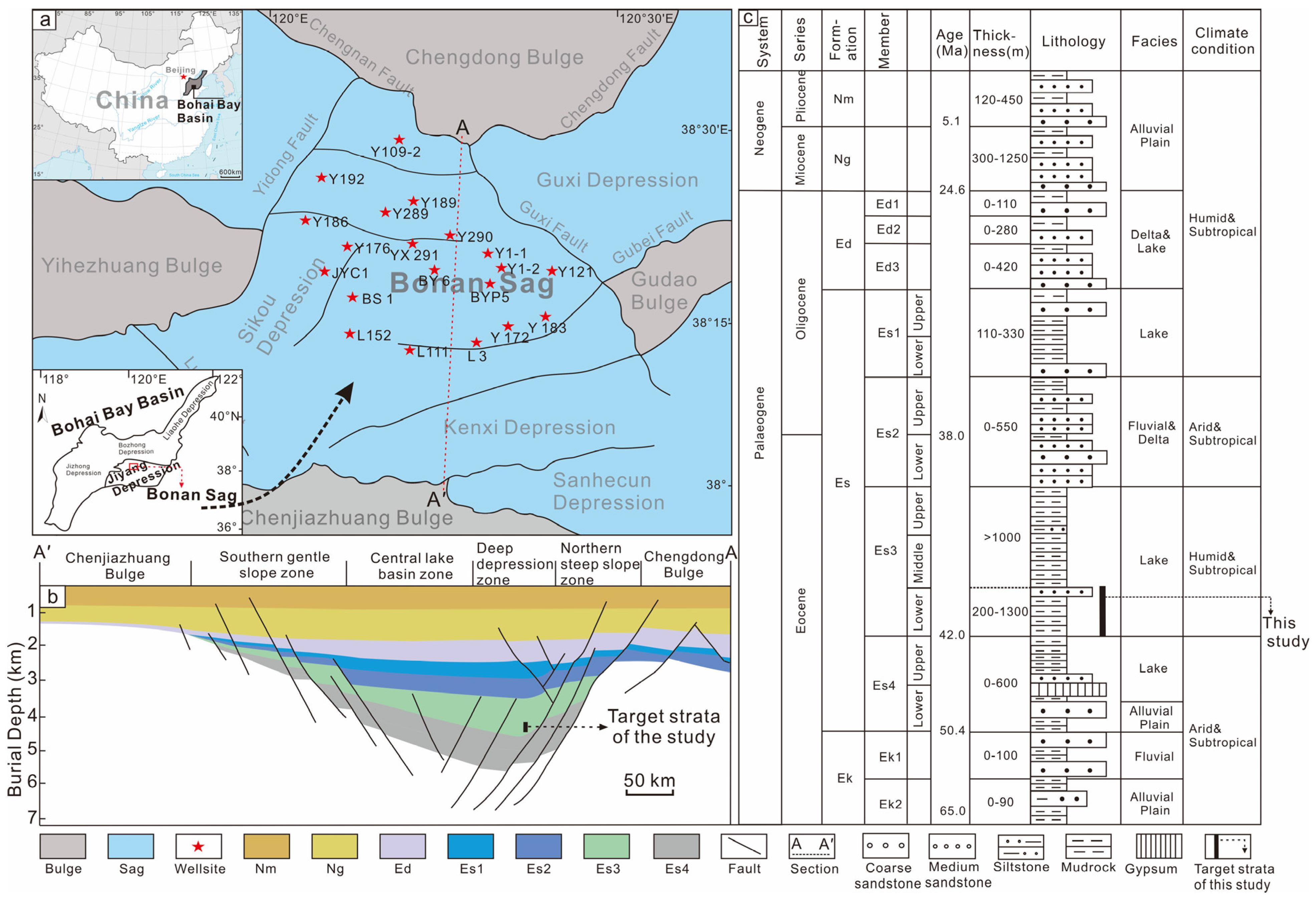
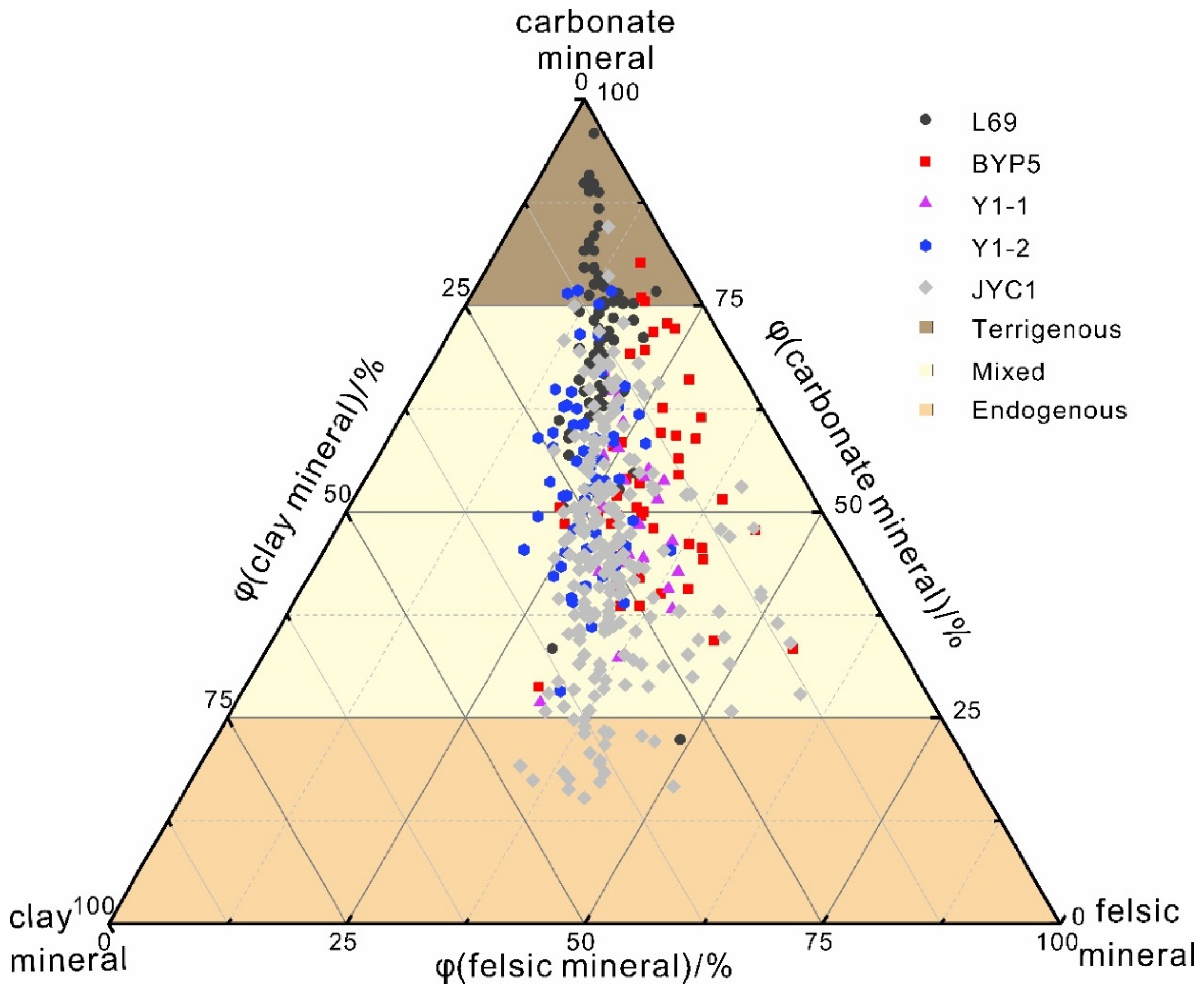
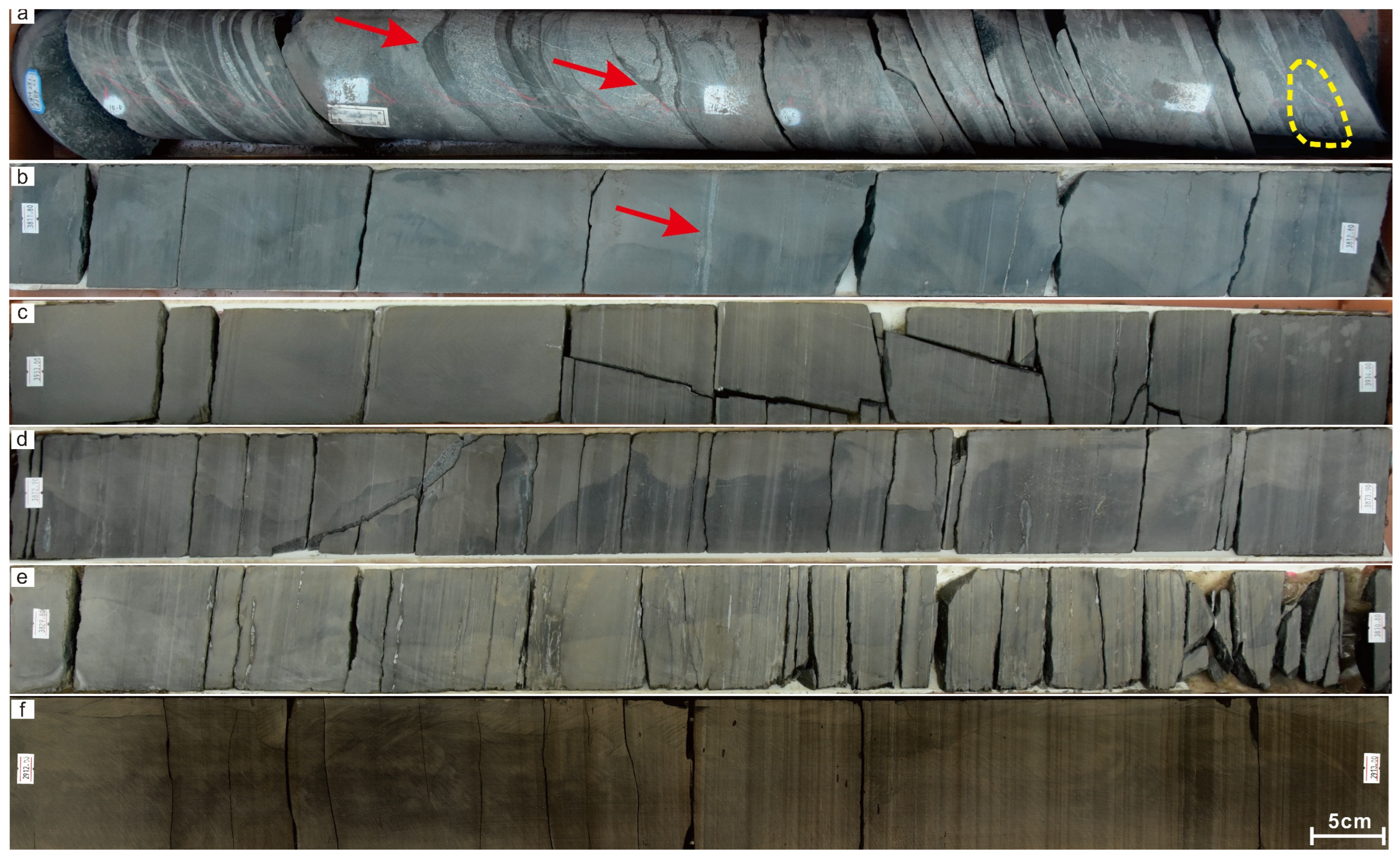
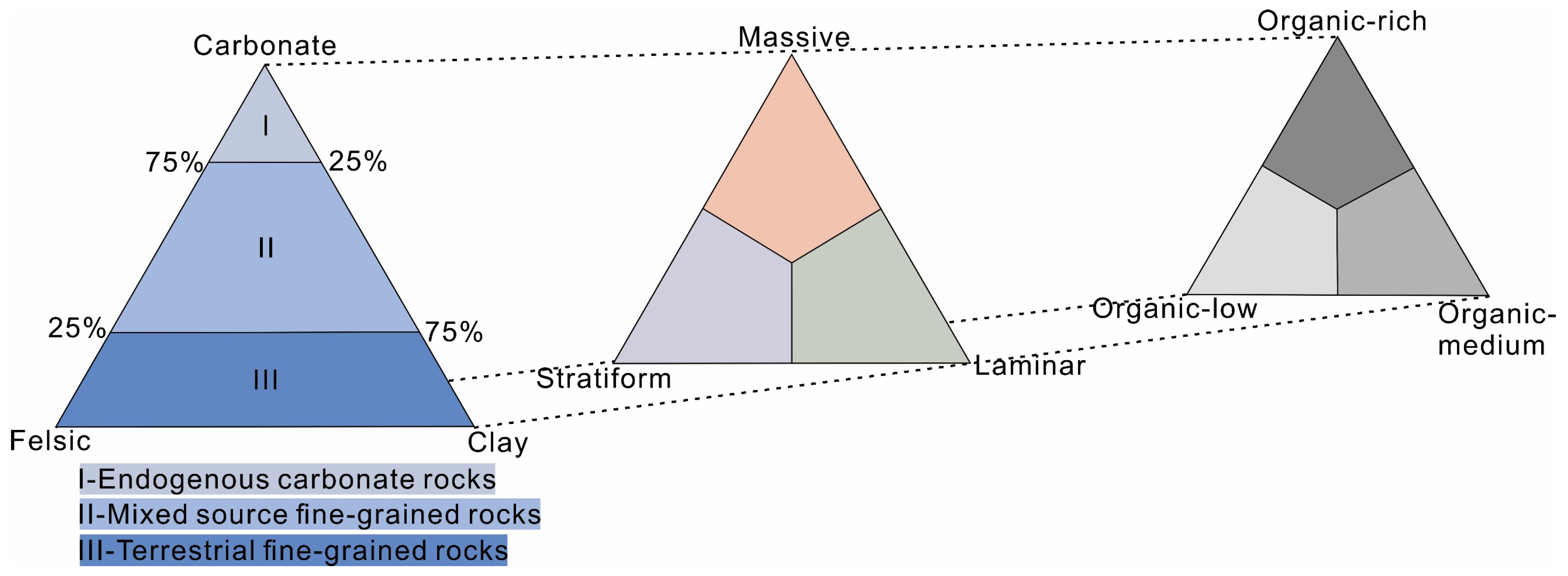
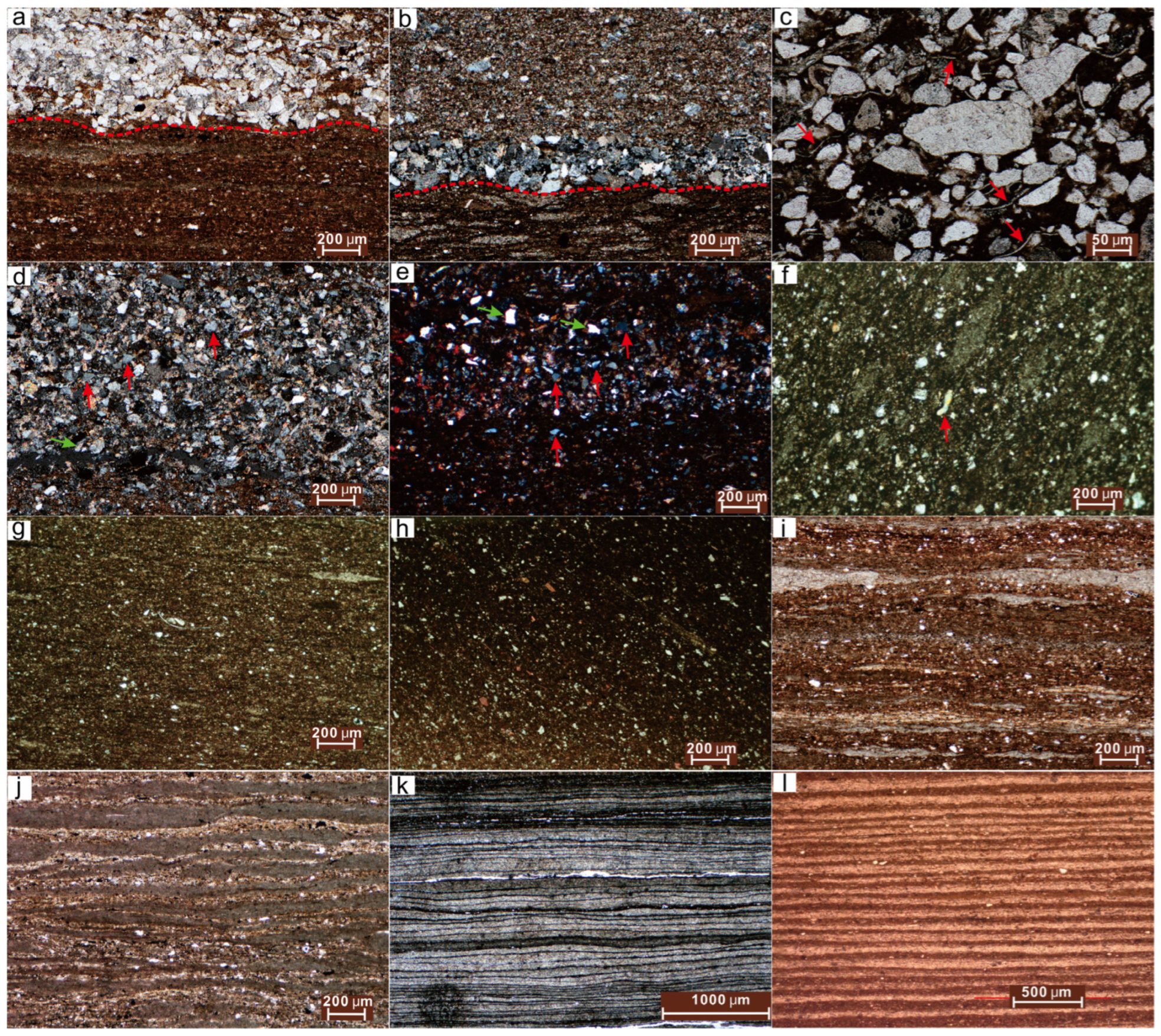


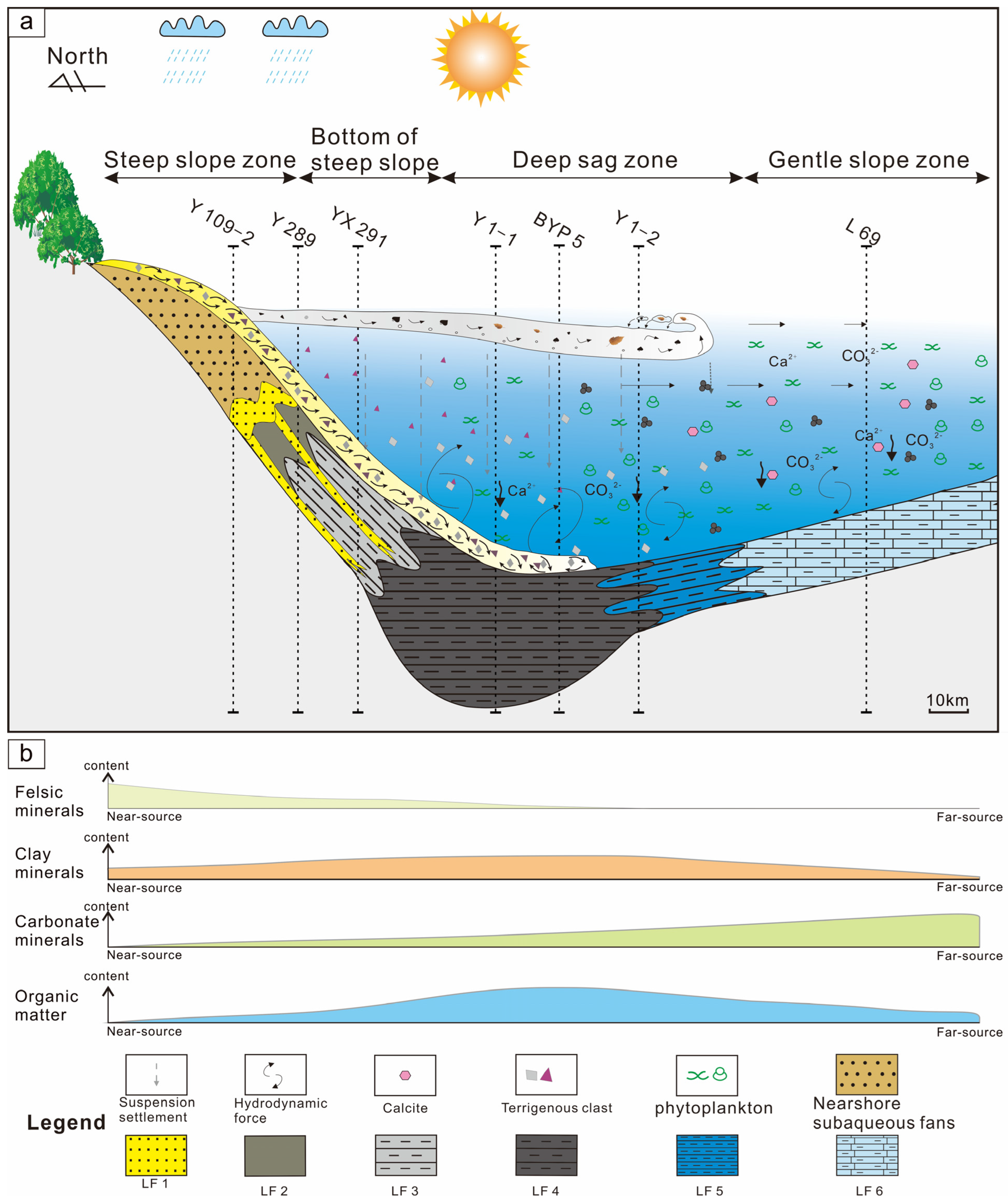
| Clay Mineral (%) | Quartz (%) | Feldspar (%) | Calcite (%) | Dolomite (%) | Pyrite (%) | TOC (%) |
|---|---|---|---|---|---|---|
| Lithofacies | Mineral Sources | TOC (%) | Depositional Structure | Lithofacies Types |
|---|---|---|---|---|
| LF1 | terrigenous | 0–2 | massive | terrigenous low-organic-matter massive siltstone |
| LF2 | terrigenous | 0–2 | massive | terrigenous low-organic-matter massive mudstone |
| LF3 | mixed-source | 2–4 | massive | mixed-source medium-organic-matter massive mudstone |
| LF4 | mixed-source | 2–6 | layer-massive | mixed-source medium-to-high-organic-matter layer-massive mudstone |
| LF5 | mixed-source | 2–6 | laminated | mixed-source medium-to-high-organic-matter laminated mudstone |
| LF6 | endogenous | 2–6 | laminated | endogenic medium-to-high-organic-matter laminated marl |
| Lithofacies | Genesis Mechanisms | Type of Reservoir Space | Porosity (%) | TOC (%) | S1 (mg/g) | Brittle Minerals (%) |
|---|---|---|---|---|---|---|
| LF1 | Terrestrial-event deposition | Intergranular pore | 8.8 | 0.5 | 1.2 | 73 |
| LF2 | Terrestrial-event deposition | Intergranular pore | 5.8 | 0.9 | 0.9 | 71 |
| LF3 | Mixed-source-event deposition | Intergranular pore | 6.2 | 2.3 | 1.8 | 68 |
| LF4 | Mixed-source-event deposition | Intergranular pore | 6.5 | 3.8 | 3.2 | 69 |
| LF5 | Mixed-source static water | Intergranular pore, intercrystalline pore | 5.3 | 3.1 | 2.0 | 72 |
| LF6 | Endogenous biochemical | intercrystalline pore | 7.3 | 3.0 | 2.1 | 77 |
Disclaimer/Publisher’s Note: The statements, opinions and data contained in all publications are solely those of the individual author(s) and contributor(s) and not of MDPI and/or the editor(s). MDPI and/or the editor(s) disclaim responsibility for any injury to people or property resulting from any ideas, methods, instructions or products referred to in the content. |
© 2024 by the authors. Licensee MDPI, Basel, Switzerland. This article is an open access article distributed under the terms and conditions of the Creative Commons Attribution (CC BY) license (https://creativecommons.org/licenses/by/4.0/).
Share and Cite
Zhong, Q.; Li, W.; Huang, H.; Jiang, J.; Zhang, J.; Li, P.; Liu, Y.; Wu, J.; Wang, F.; Tan, B.; et al. Distribution Characteristics and Hydrocarbon Significance of Deep-Water Fine-Grained Sedimentary Rocks in the Steep-Slope Zone of a Graben Lake Basin: A Case Study of Es3l sub-Member in the Jiyang Depression, Bohai Bay Basin, China. Minerals 2024, 14, 882. https://doi.org/10.3390/min14090882
Zhong Q, Li W, Huang H, Jiang J, Zhang J, Li P, Liu Y, Wu J, Wang F, Tan B, et al. Distribution Characteristics and Hydrocarbon Significance of Deep-Water Fine-Grained Sedimentary Rocks in the Steep-Slope Zone of a Graben Lake Basin: A Case Study of Es3l sub-Member in the Jiyang Depression, Bohai Bay Basin, China. Minerals. 2024; 14(9):882. https://doi.org/10.3390/min14090882
Chicago/Turabian StyleZhong, Qi, Wangpeng Li, Hui Huang, Jianhui Jiang, Jianguo Zhang, Pinxie Li, Yali Liu, Jiabin Wu, Fenghua Wang, Bintian Tan, and et al. 2024. "Distribution Characteristics and Hydrocarbon Significance of Deep-Water Fine-Grained Sedimentary Rocks in the Steep-Slope Zone of a Graben Lake Basin: A Case Study of Es3l sub-Member in the Jiyang Depression, Bohai Bay Basin, China" Minerals 14, no. 9: 882. https://doi.org/10.3390/min14090882
APA StyleZhong, Q., Li, W., Huang, H., Jiang, J., Zhang, J., Li, P., Liu, Y., Wu, J., Wang, F., Tan, B., & Jia, R. (2024). Distribution Characteristics and Hydrocarbon Significance of Deep-Water Fine-Grained Sedimentary Rocks in the Steep-Slope Zone of a Graben Lake Basin: A Case Study of Es3l sub-Member in the Jiyang Depression, Bohai Bay Basin, China. Minerals, 14(9), 882. https://doi.org/10.3390/min14090882




